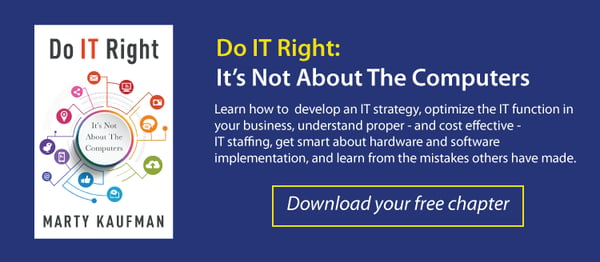Remember when the Cloud meant fluffy white figures in the sky? Believe me, you aren’t the only one who struggles with “the Cloud” and what it means. The good news is that we're here to help you figure out the difference in the types of cloud computing and how to pick the right one for you.
Watch the video or continue reading below:
No extra Googling required with this simple introduction to the types of cloud computing and the many different flavors it comes in. We’re also going to take a bunch of acronyms that make up some pretty confusing alphabet soup and simplify it. So, you can get your head, or rather, your business, in the Cloud.
Here’s part one in this 3-part series on cloud computing.
What’s the Difference Between SaaS, IaaS, and PaaS?
There are three major types of cloud computing services that encompass nearly every type of cloud offering you can purchase today. Like many things in the IT world, they are described by acronyms that can be very unclear. Let’s break them down.
Software-as-a-Service (SaaS) or Cloud Services
Most people have at least heard of the term “SaaS,” which stands for “Software-as-a-Service”. In this model, you pay a subscription fee (typically monthly or annually) for access to the software.
The provider hosts the software for you, so you don’t have to worry about hardware, servers, operating systems, or anything like that. You’ll also always have the most updated version of the software. All you need to do is manage who has access to it and how they access it.
An example would be Microsoft’s Office 365. You pay a monthly or annual fee for your employees’ software subscriptions instead of buying one-time Office licenses for each employee. We’ll dive in to more examples below.
Platform-as-a-Service (PaaS)
Moving one step down from SaaS, we have “PaaS” which stands for “Platform-as-a-Service”. This is the least common of the three for most small and medium businesses. It is primarily aimed at software developers.
Essentially, you get a platform to build your software, but you don’t have to worry about hardware or servers. If you’re new to cloud computing and investigating options for your business, it’s unlikely PaaS will be the choice for you because of its specific use case.
Infrastructure-as-a-Service (IaaS) or Cloud Servers
One more step down from PaaS is “IaaS” or “Infrastructure-as-a-Service”. This is one of the most common ways that businesses migrate to the Cloud.
It's the most similar to what you have in your server room, just hosted by someone else. With IaaS, you still have servers to manage, but you won’t have to worry about the hardware or virtualization.
Related: Learn about cloud migrations and ongoing support for Southern California organizations.
What’s the Difference Between Cloud Services and Cloud Servers?
Taking PaaS out of the equation, we can simplify these types of cloud computing into “Cloud Services” and “Cloud Servers”.
Now, what are they? Let’s talk about some examples of each.
Examples of Cloud Services (SaaS)
It is very likely that you use Microsoft Office 365 or Google’s G Suite for your business email and collaboration. No? What about Salesforce.com? Dropbox? WebEx? GoToMeeting? Slack?
These are all typical examples of cloud services, and the list goes on and on.
In an ideal environment, your business would run entirely on cloud services. How great would it be to not to have to deal with server maintenance or to have to refresh hardware every few years?
There are still challenges with cloud services that require IT support though. The two most important are 1) the integration between all your cloud services and 2) maintaining a single identity for your users in each of them.
Your cloud services will likely be hosted with several different providers. Getting them all to talk to each other and play nice can be a big challenge.
Each account will probably also have a separate login which means that users will have to maintain separate credentials for each service unless you can get them to sync or point to a central authentication service.
This is where your IT heroes swoop in to save the day and keep your users from pulling their hair out.
Examples of Cloud Servers (IaaS)
There are a lot of businesses that need to keep servers around. This is typically due to line of business applications or custom-written applications that require dedicated servers.
In these cases, you would either migrate to a hybrid environment of cloud servers and cloud services or make the switch to all cloud servers.
There are a lot of different providers of cloud servers. The most common are Microsoft’s Azure, Amazon’s AWS and Google’s Cloud Platform.
How to Pick Between Cloud Services or Cloud Servers
Choosing the right path for your business to migrate to the Cloud can be difficult. You will definitely want to consult with your IT team first to determine the feasibility of each option.
Ultimately, it will be your business processes, your line of business applications, and your determination to migrate that will make most of the decision for you.
It's much easier and less disruptive to migrate to cloud servers than it is to migrate to cloud services. While migrating to cloud servers will get you into the Cloud, the ongoing server maintenance and refresh cycles remain.
Stay tuned for the rest of this three-part series where we will talk more about the two main Cloud options, cloud servers (IaaS) and cloud services (SaaS) in more depth.
Cloud Consulting
You don't have to be an IT expert to make the wise decisions about cloud computing when you have an IT business partner like VC3 on your side. Give us a call today and explore how you can get ongoing technology consulting while dramatically improving your IT experience.
Get in touch here , call us at 800-481-4369 or move on to part 2 of this series.



